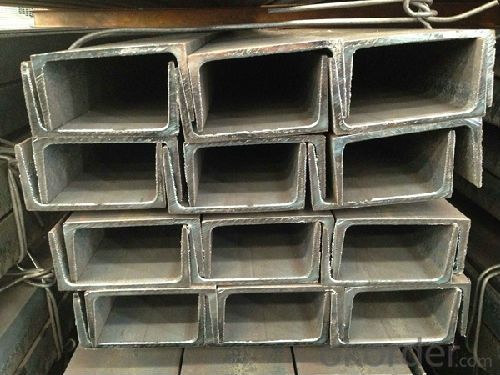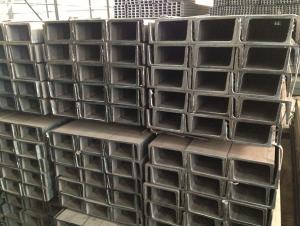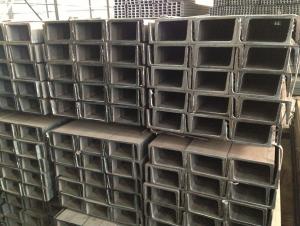GB Steel Channel Q235 With High Quality
- Loading Port:
- China main port
- Payment Terms:
- TT or LC
- Min Order Qty:
- 25 m.t
- Supply Capability:
- 2000 m.t/month
OKorder Service Pledge
OKorder Financial Service
You Might Also Like
Product Applications:
GB Steel Channel Q235 With High Quality re ideal for structural applications and are widely used in the construction of buildings and bridges, and the manufacturing, petrochemical, and transportation industries.
Product Advantages:
OKorder's GB Steel Channel Q235 With High Quality are durable, strong, and resist corrosion.
Main Product Features:
· Premium quality
· Prompt delivery & seaworthy packing (30 days after receiving deposit)
· Corrosion resistance
· Can be recycled and reused
· Mill test certification
· Professional Service
· Competitive pricing
The steel u channel will be packed in bundle with steel wire at each end of every bundle and color marking in order to help the customer to recognize his goods more easily at sight.
And steel u channel could be loaded into 20ft or 40ft container, or by bulk cargo. If the weight of each bundle reaches less than 3.5 mt, the loading by break bulk cargo should be choosed. When the weight of each bundle reaches less than 3mt, the loading by container should be choosed.
As for the transportaion from mill to loading port, the truck will be usually used. And the maximum quantity for each truck is 40mt.
All in all, we could do in accordance with customer's request.
Trade terms: FOB, CFR, CIF
FAQ:
Q1: Why buy Materials & Equipment from OKorder.com?
A1: All products offered byOKorder.com are carefully selected from China's most reliable manufacturing enterprises. Through its ISO certifications, OKorder.com adheres to the highest standards and a commitment to supply chain safety and customer satisfaction.
Q2: How do we guarantee the quality of our products?
A2: We have established an advanced quality management system which conducts strict quality tests at every step, from raw materials to the final product. At the same time, we provide extensive follow-up service assurances as required.
Q3: How soon can we receive the product after purchase?
A3: Within three days of placing an order, we will begin production. The specific shipping date is dependent upon international and government factors, but is typically 7 to 10 workdays.
Images:


- Q:How do steel channels perform in corrosive chemical environments?
- Steel channels generally perform well in corrosive chemical environments due to their high resistance to corrosion. This is primarily because steel, especially stainless steel, forms a protective oxide layer that prevents or slows down the corrosion process. However, the exact performance can vary depending on the specific chemical environment and concentration. It is important to consider the corrosive properties of the chemicals and consult with experts or engineers to select the appropriate type and grade of steel channel for optimal performance and longevity in corrosive chemical environments.
- Q:How do steel channels contribute to the stability of a structure during high winds?
- Steel channels contribute to the stability of a structure during high winds by providing additional support and reinforcement. They are typically used in the construction of frames and beams, helping to distribute the wind load evenly throughout the structure. The channels help to prevent excessive deflection or deformation, ensuring that the structure remains stable and less susceptible to wind-induced forces.
- Q:What are the different types of connections used for steel channels in roof trusses?
- There are several different types of connections that can be used for steel channels in roof trusses. Some of the most common types include: 1. Welded connections: This involves welding the steel channel directly to the other components of the roof truss, such as gusset plates or other steel members. Welded connections provide a strong and rigid connection, but they require skilled labor and can be time-consuming. 2. Bolted connections: Bolts are used to connect the steel channel to other components of the roof truss. This type of connection is easier to install compared to welding and can be disassembled if needed. It provides a strong connection, but there is a risk of bolts loosening over time and requiring regular maintenance. 3. Pinned connections: In this type of connection, a pin or a bolt is used to connect the steel channel to other components of the roof truss. Pinned connections allow for rotational movement, which can be advantageous in certain applications but may require additional support to prevent excessive movement. 4. Cleat connections: Cleats are flat plates that are bolted or welded to the steel channel and other components of the roof truss. This type of connection is commonly used for connecting purlins or rafters to the steel channel. Cleat connections provide good load transfer and are relatively easy to install. 5. Gusset plate connections: Gusset plates are typically used in conjunction with bolted or welded connections to provide additional strength and rigidity. These plates are usually made of steel and are bolted or welded to the steel channel and other components of the roof truss. The choice of connection type depends on various factors such as the structural requirements, load capacity, ease of installation, and maintenance considerations. It is essential to consult with a structural engineer or a professional with expertise in roof truss design to determine the most suitable connection type for a specific application.
- Q:Are steel channels suitable for use in marine environments?
- Yes, steel channels are suitable for use in marine environments. Steel is known for its high strength and durability, making it an ideal material for marine applications. Steel channels are commonly used in the construction of ships, offshore structures, and other marine equipment. One of the main reasons why steel channels are suitable for marine environments is their resistance to corrosion. Steel can be coated with protective layers such as galvanization or epoxy paint to prevent rusting and corrosion caused by saltwater exposure. These coatings create a barrier between the steel and the corrosive elements in marine environments, prolonging the lifespan of steel channels. Additionally, steel channels offer excellent structural integrity and load-bearing capacity. They can withstand the harsh conditions of the sea, including waves, currents, and extreme weather events. Steel channels are also capable of supporting heavy loads, making them suitable for various marine applications such as shipbuilding, dock construction, and offshore platforms. Furthermore, steel channels have good fire resistance properties, which is crucial for safety in marine environments. In the event of a fire on a ship or offshore structure, steel channels can help contain the spread of flames and maintain the structural integrity of the vessel or platform. However, it is important to note that regular maintenance and inspection are necessary to ensure the ongoing suitability of steel channels in marine environments. Periodic inspections for signs of corrosion or damage and timely repairs or replacements are essential to maintain the structural integrity and safety of steel channels in marine applications. In conclusion, steel channels are indeed suitable for use in marine environments due to their high strength, corrosion resistance, load-bearing capacity, and fire resistance properties. With proper maintenance and inspection, steel channels can provide long-lasting performance in marine applications.
- Q:How are steel channels installed?
- Steel channels are typically installed by following a series of steps. The first step is to determine the appropriate location and layout for the channels. This involves measuring and marking the positions where the channels will be installed. Once the layout is determined, the next step is to prepare the area for installation. This may involve clearing any debris or obstructions, ensuring a level surface, and making any necessary adjustments. The steel channels are then positioned in the designated locations. This is typically done by using a crane or other lifting equipment to carefully place the channels into position. It is important to ensure that the channels are properly aligned and level during installation. After the channels are in place, they are secured using various methods. This may involve welding, bolting, or other fastening techniques, depending on the specific requirements and design of the installation. Finally, once the channels are securely installed, any necessary finishing touches can be made. This may include painting, applying protective coatings, or making any necessary adjustments to ensure proper functionality. Overall, the installation of steel channels requires careful planning, precise measurements, and proper securing techniques to ensure a safe and effective installation. It is important to follow industry standards and guidelines to ensure the channels are installed correctly and will perform as intended.
- Q:In the construction engineering construction site, such as channel material piled reinforced why mat wood, directly on the concrete floor (ground) on the surface is not?
- 1. Prevent rust.2. Keep the component clean and non clay. Otherwise, the rain will take enough time to clean the components.3. Convenient transportation. When the component is high, it is convenient to wear a steel rope to bind, a bundle of steel bars, the transportation efficiency is high; you put the steel bar directly on the ground, and later inconvenient to transport by crane, can only move out one by one.
- Q:What are the different methods of surface preparation for steel channels?
- Steel channels can be prepared for surface treatment in various ways, each with its own purpose and outcomes. Some commonly utilized methods are as follows: 1. To rid the surface of rust, scale, and contaminants, abrasive blasting is employed. This technique involves propelling abrasive particles onto the steel channels using high-pressure air or water. It leaves behind a clean and rough surface, ready for further treatment or coating. 2. Chemical cleaning involves the use of chemicals to eliminate surface contaminants and oxides from the steel channels. Acid pickling is a prevalent chemical cleaning process, where the channels are submerged in an acid bath to dissolve rust and scale. Another method is alkaline cleaning, which employs alkaline solutions to remove organic contaminants. 3. Mechanical cleaning necessitates the use of mechanical tools like wire brushes, scrapers, or sandpaper to physically eliminate contaminants from the surface of the steel channels. It is typically employed for smaller areas or specific cleaning needs. 4. Power tool cleaning involves the use of power tools such as grinders, sanders, or wire brushes to mechanically clean the surface of the steel channels. This method is effective in removing heavy rust, mill scale, and coatings. 5. Solvent cleaning involves using solvents to dissolve and eliminate contaminants from the surface of the steel channels. It is commonly used for light cleaning and degreasing purposes. 6. Water jetting is a method that utilizes high-pressure water jets to clean the surface of the steel channels. It is efficient in removing loose rust, paint, and other debris. Choosing the appropriate method of surface preparation is crucial, taking into consideration the specific requirements of the steel channels, such as the extent of surface contamination, desired cleanliness level, and the type of coating or treatment to be applied. Following the appropriate surface preparation process ensures better coating adhesion, improved corrosion resistance, and enhanced overall performance of the steel channels.
- Q:Can steel channels be used for balcony railings?
- Yes, steel channels can be used for balcony railings. Steel channels are strong and durable, making them suitable for providing support and safety on balconies. They can be customized to fit the specific dimensions and design requirements of the balcony. Additionally, steel channels are corrosion-resistant and can withstand harsh weather conditions, making them a reliable choice for outdoor applications. Whether it is for residential or commercial purposes, steel channels offer a versatile and aesthetically pleasing option for balcony railings.
- Q:What are the different methods of surface finishing for steel channels?
- There are several methods of surface finishing available for steel channels, each with its own unique benefits and applications. Some of the most common methods include: 1. Painting: Painting is a widely used method for surface finishing steel channels. It provides an aesthetically pleasing finish and protects the steel from corrosion and other environmental factors. Different types of paints can be used, such as epoxy, polyurethane, or enamel, depending on the specific requirements of the application. 2. Galvanizing: Galvanizing is a process that involves coating steel channels with a layer of zinc. This method provides excellent corrosion resistance, making it suitable for outdoor or harsh environments. Hot-dip galvanizing and electroplating are two commonly used techniques for galvanizing steel channels. 3. Powder coating: Powder coating is a dry finishing process where a powdered paint is electrostatically applied to the surface of steel channels. The coated channels are then heated to fuse the powder into a smooth and durable finish. Powder coating offers a wide range of color options, excellent resistance to chipping, and high durability. 4. Anodizing: Anodizing is typically used for aluminum, but it can also be used for steel channels. It involves creating an oxide layer on the surface of the steel through an electrochemical process. Anodized steel channels have enhanced corrosion resistance and can be dyed in various colors. 5. Plating: Plating is a technique that involves depositing a thin layer of metal, such as chrome, nickel, or zinc, onto the surface of steel channels. This method provides aesthetic appeal, improved corrosion resistance, and can also enhance hardness or lubricity. 6. Polishing: Polishing is a mechanical process that involves using abrasives to create a smooth and shiny surface on steel channels. This method is often used for decorative purposes or to improve the visual appearance of stainless steel channels. Each method of surface finishing has its own advantages and considerations, and the choice depends on factors such as aesthetic requirements, corrosion resistance, durability, and cost-effectiveness. It is important to consider the specific application and consult with professionals to determine the most suitable surface finishing method for steel channels.
- Q:Standard size and price of 12# channel steel...
- According to the 05 building system quota, the specification 120*53*5.5 (unit mm), the unit price is 4739.90 yuan per ton.
1. Manufacturer Overview |
|
|---|---|
| Location | |
| Year Established | |
| Annual Output Value | |
| Main Markets | |
| Company Certifications | |
2. Manufacturer Certificates |
|
|---|---|
| a) Certification Name | |
| Range | |
| Reference | |
| Validity Period | |
3. Manufacturer Capability |
|
|---|---|
| a)Trade Capacity | |
| Nearest Port | |
| Export Percentage | |
| No.of Employees in Trade Department | |
| Language Spoken: | |
| b)Factory Information | |
| Factory Size: | |
| No. of Production Lines | |
| Contract Manufacturing | |
| Product Price Range | |
Send your message to us
GB Steel Channel Q235 With High Quality
- Loading Port:
- China main port
- Payment Terms:
- TT or LC
- Min Order Qty:
- 25 m.t
- Supply Capability:
- 2000 m.t/month
OKorder Service Pledge
OKorder Financial Service
Similar products
New products
Hot products
Related keywords





























